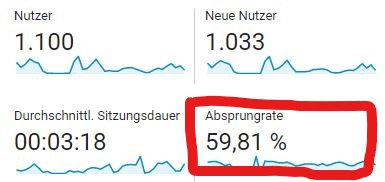Bounce Rate (Absprungrate)
Die Bounce Rate (Deutsch= Absprungrate) ist ein wichtiger Bestandteil des Webmonitorings. Sie ist ein wertvoller KPI (Indikator) für einen Webmaster. Die Absprungrate wird mit den Usern definiert, die lediglich einen Aufruf einer Webseite erzeugen.
Definition
Man sucht z.B. im Internet nach einer Versicherung und landet auf einer Seite die unseriös wirkt und schließt diese wieder. Somit zählt dieser Seitenaufruf zur Bounce Rate.

Natürlich können die Gründe für den Absprung verschieden sein. Trotzdem hilft diese Kennzahl beim analysieren des Erfolges bspw. einer AdWords Kampagne. Aber auch im Email-Marketing ist die Bounce Rate ein wichtiger Indikator.
Wie berechne ich die Bounce Rate?
Es gibt unterschiedliche Möglichkeiten die Bounce Rate zu berechnen.
Die Grundformel ist jedoch einfach:Besucher mit nur einem Seitenaufruf / alle Webseitenbesucher x 100 = Bounce Rate in Prozent
Beispiel: 1876 / 3845 x 100 = 48,79 %Fazit: Fast die Hälfte aller Besucher die diese Webseite besuchen interagieren nicht weiter mit dieser Seite und verlassen diese nach kurzer Zeit (i.d.R. 5-10 Sekunden). Dieser Wert hört sich schlecht an aber muss immer individuell interpretiert werden, da die Absprünge verschiedenste Gründe haben können.
Durch weitere Kennzahlen wie die “Page Impressions”, „Pageview hits“, die aussagen, dass ein Nutzer lediglich die Seite gesehen hat oder die E-Commerce „transaction item hits“, die Aufschluss über in den Warenkorb gelegte Artikel gibt. Mit diesen KPI kann der Wert der Bounce Rate verfeinert werden.
Interpretation der Bounce Rate
Die Frage zur Auswertung bzw. Interpretation ist schwierig zu beantworten, da es dazu verschiedene Ansätze gibt. Dafür gibt es keine „Pauschalantwort“.
Eine sehr hohe Absprungrate muss nicht zwangsläufig negativ sein. Eine Kontaktseite mit Anschrift gibt dem User schnell was er sucht. Dann ist es normal, dass er diese Seite nach sehr kurzer Zeit wieder verlässt.
Benchmarks aus der entsprechenden Branche bieten einen Anhaltspunkt für die Beurteilung der Werte.
Berücksichtigung wichtiger Faktoren
Die Ursprungsseite sollte thematisch zur Zielseite passen. Ansonsten ist dies ein klares Indiz für ein sofortiges Verlassen der Seite.
Ebenso wichtig sind die technischen Faktoren. Wenn eine Seite eine lange Ladezeit aufweist oder nicht mobil optimiert ist, kann das ebenfalls ein Grund für das Verlassen der Seite sein.
Auch organischer Traffic kann zur Steigerung der Bounce Rate beitragen. Branded Traffic hingegen führt eher zu Minderung.Gut zu wissen: Mobile User verlassen Webseiten generell schneller als User die Zuhause am Computer sitzen.
Return to SERP Rate
Die SERP Rate steht eng in Verbindung mit der Bounce Rate doch unterscheidet sich trotzdem wesentlich.
Bei dieser Rate wird festgehalten, wie viele Besucher der Webseite nach verlassen der Webseite zurück zu den Suchergebnissen zurückkehren und z.B. auf anderen Seiten weitersuchen, die Suche verfeinern oder nach etwas Anderem suchen.
Ursachen einer hohen Bounce Rate
Ein Grund, den jeder Internetnutzer bestimmt schon einmal erlebt hat ist, dass man nicht das findet, was man sucht. Entweder ist der Content einfach unpassend, minderwertig oder erst nach langem scrollen zu finden. Optimierungen am Inhalt oder Layout könnten hier zur Minderung beitragen.
Es kann allerdings auch vorkommen, dass der Trackingcode des Webanalyse-Tools nicht korrekt eingebettet wird und somit falsche Daten übermittelt.
Einfluss auf SEO
Die Absprungrate ist ein klarer Indikator der unbedingt beachtet werden sollte. Sie kann ein Anhaltspunkt für Optimierungsbedarf sein, muss es aber nicht.
Ebenso wichtig wie der KPI an sich, ist der Webmaster der diese auswertet. Wird die Bounce Rate falsch interpretiert, so werden eventuell auch falsche Maßnahmen zur Optimierung ergriffen.
Als Fazit lässt sich jedoch sagen, dass man die Bounce Rate nie alleine betrachten sollte. Man sollte mehrere Indikatoren hinzuziehen wie beispielsweise die Dauer des Aufenthalts.
Fazit
Die Bounce Rate (Absprungrate) kann dir als Webmaster ein wichtiger Indikator dafür sein, ob Besucher eine Unterseite so nutzen wie du dir es vorgestellt hat. Dafür solltest du den Wert aber immer in Abhängigkeit von anderen Metriken betrachten.
Vorsicht: Die Begriffe Absprungrate und “Ausstiegsrate” werden oft verwechselt.
Um einen “Ausstieg” handelt es sich, wenn ein Nutzer auf eine weitere Unterseite klickt und dann die Webseite verlässt!

Your comment has been sent successfully.
Your comment will be checked
Das könnte dich auch interessieren:
Webcrawler: was macht ein Crawler?
Ein Crawler (Webcrawler) ist ein Software-Programm, das automatisiert das Internet durchsucht und “scannt”. In der...
Gastbeitrag
„Guest Posting“ ist der englische Begriff für „Gastbeitrag“. Er bezeichnet die Veröffentlichung von Inhalten eines...
htaccess
Die htaccess-Datei ist eine verzeichnisspezifische Konfigurationsdatei für NCSA-kompatible Webserver. Dazu zählt beispielsweise der Apache-Webserver. Die...

